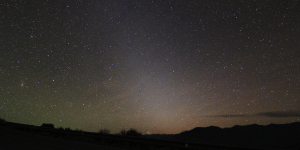Blog
Zodiacal Light
8 July 2015
 Peter Detterline
Peter DetterlineMost of the solar system lies within a flat plane. The plane in which the Earth orbits is known as the ecliptic, and the orbits of the other seven planets are all within a few degrees of the ecliptic. The ecliptic is usually defined as the path the Sun traces through the sky in a given year. Because of the orbit of the Earth about the Sun, the Sun appears to move along the ecliptic during the year. Because the Moon and other planets all orbit within a few degrees of this plane, you can always find the Sun, Moon and planets in the general region of the ecliptic.
The reason for the planets lying in this common plane has to do with the way planetary systems form. As a cloud of gas and dust begins to collapse into a star, its rotation causes it to flatten into a disk. This gives rise to a protostar at the center of the cloud, with a protoplanetary disk surrounding it. We see such protoplanetary disks in stellar nurseries, such as the Orion nebula.
As planets begin to form within the protoplanetary disk, much of the material is either captured by planets or scattered to the outer regions of the system (such as the Oort cloud). But the planets don’t capture all the material. There remain asteroids and meteorites, and even smaller grains of dust. Like the planets, much of this dust lies within the plane of the solar system. Collisions between asteroids, cometary dust and other processes also contribute to this dust.
We can see this dusty plane at during the Spring and Fall, when the ecliptic is titled far from the horizon. It can only be seen in dark skies, either before sunrise or after sunset. It is more commonly observed before sunrise as a dim glow, which is why it is sometimes called the false dawn.
It is more commonly known as the zodiacal light, because it is seen along the ecliptic, and the plane of the ecliptic is also the region in which the zodiac constellations lie. If you ever catch a glimpse of this zodiacal light, you’ll have seen the dust of our solar system.